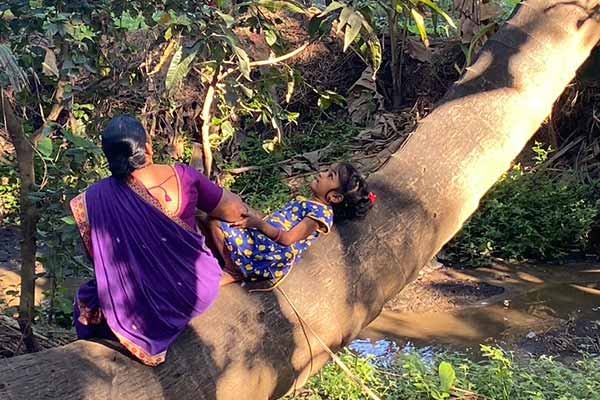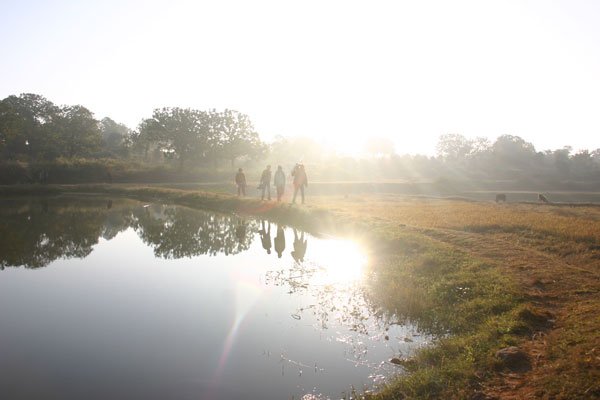


A life-size shadow on the wall with #missing #every8minutes began a journey like no other. A six-year-long process on understanding the very sensitive issue of child sex trafficking. The story unfolds in a way that would evoke a response in the audience so they engage in meaningful ways rather than increase passivity or dread. How does one gauge, measure and channelize the audience response to one of the most pressing issues of our time?

We began tapping the impact potential of the film, an intensive and committed journey of navigating a legal minefield around an ongoing case, working out survivor consent at every stage and the implications when key characters are at risk. It meant signing on a legal team, bringing on an Impact Producer, raising new finances and committing an extra year to go beyond festival screenings and reach the audience who could make a difference. This meant screenings to youth in colleges, grass root screenings in vulnerable communities where we ferried projector and screen, organizing special screenings at cultural forums, for law enforcement, judiciary, policy makers and anti-trafficking stakeholders.

TOne does not have to go to exotic locations to discover a good story, many surprises lie buried in the hustle of everyday living. I live in a high-rise apartment and I discovered we have leopards that stray into our neighbourhood. A trap with a bleating goat is set up. A majestic roar tells us he has been trapped. The leopard eyes blazing behind bars confronts me about humanity’s relationship to its habitat. Is it the leopard encroaching on the urban jungle or is the city taking over his turf?

A filmmaker living in Mumbai for 20 years, I had no idea that there was a 10,000 strong forest dwelling community with their own unique culture within the same city. When I visited the Bhoir family I gasped at their home in the forest. Stunning wall art with pictorial histories of their philosophy alongside small altars to the leopard, their deity and daily friend.
I felt compelled to tell this fascinating tale of coexistence in a city that has been encroaching on its own green lungs at a terrifying rate. India has some of the most polluted cities in the world yet lost additional 14% of tree cover during the pandemic. This is most apparent in Mumbai, a city of 18 million gasping for breath.

The very rare Indo-Pak co production shot over 3 years. A Pakistani rockstar dares to teach a group of young girls from Lyari, Karachi’s most volatile district how to express themselves through music. A film about music and resistance that explores a journey to self expression amidst cycles of violence… Lyari Notes was one of the 16 projects selected for the International Documentary Festival of Amsterdam Summer School 2013. Maheen (co director based in Karachi) and Miriam (co director based in Mumbai) met for the first time not in India or in Pakistan but in Amsterdam after one year of working on the film! We had been working on the concept of the film together over internet, skype and every new technology that helped us overcome a hostile border that separates our two countries. What kept us going is the belief that this film is about music that transcends boundaries creating a new and refreshing dialogue. Maheen shot in Karachi (Pakistan) and Miriam edited in Mumbai (India). The film had a world premiere at IDFA, Amsterdam the biggest documentary festival in the world and this photo was taken on their big day. It was nominated by the Alliance of Women Film Journalists for the EDA Award for the contribution of women directors to documentary film making and for the Youth Jury Award at Sheffield. It was the opening film at the Artists Cinema Package, Kochi Biennale as well as at Indie Meme, Austin USA.

The era of commissions ended. I discovered a story that unfolds in my city I could self finance. It allowed me to shoot at night after my 4-year old son was asleep and return home early morning to get him ready for kindergarten. The Rat Race (2011) is the true-life tale of a small army of men who work after midnight with a torch and a stick to protect India’s commercial capital from rodents. Directing and producing this film began with a shoestring budget until it won the Mipdoc Co production challenge at Cannes and got support from the IDFA-Bertha Fund for post production. It premiered at IDFA and was one of the first documentaries to get a theatrical release in India. The protagonist of my film Behram Harda dreamt of being a dancer in Bollywood but had instead spent a lifetime counting the carcasses of rats. When the documentary had a theatrical release he was a special guest in a packed theatre. He declared “ so what if I killed rats I am still like James Bond with a license to kill”. Amidst the applause we both knew this was the moment his dream had come true his true life story had made it to the big screen. The film was broadcast internationally on Arte (France), DR (Denmark), RSI (Switzerland), YLE (Finland) and Netflix (worldwide). This is a photo of Behram Harda having is moment dancing on stage at the press conference before the theatrical release.



Jungle adventure in Jharkhand.
“Play safe and don’t stick to the same pattern…Infact don’t inform anybody of your plans” “Do not stay on in the forest after dark in fact you should not even be on the roads” We were to shoot ‘A light burns’ in the forests of Jharkhand. A naxal heartland, known to be a battleground between the armed forces and the naxals, we set out with a lot of trepidition ignoring all warning. We had no choice. The shoot was planned over two days and there was no question of returning before dark our shoot was about a forest dwelling community’s efforts to generate electricity using bio diesel and night shots with lights burning were intrinsic to telling the story.
Two village boys on a motorbike led the way across a rugged terrain. Hamlets and huts grew scattered and the vegetation dense…until we were careening through the smallest mud paths and rocky ridges to arrive in the village of Gardih. We were told that only two members of the crew could stay overnight in the village to get shots of the lights burning and the leaf plate weaving that the women do even late in the night. The cameraman and assistant, it was decided would stay. It was a fitful, sleepless night for the rest of the crew…as all the warnings before the shoot played back eerily. In the darkness of 4:00am on a winter morning, the team huddled into the car and sped back to the village only to spot the cameraman capturing a spectacular sunrise after a hard night’s shoot!



Two year old labour of love!
Robot Jockey was commissioned the day Miriam’s son was born. She had to begin pre production work as soon as she was out of the hospital and leave for the first shoot in Qatar when he was barely a few months old. The film has been made over 2 years with over 60 hours of footage.
Four cameras in the camel race
It was truly challenging, shooting the camel races. As many as 30-60 camels take part in a race and they lurch forward seeming to almost collide with each other right at the very start. The spectators besides catching the start and end of the race get the chunk of action of the marathon endurance course from television screens fitted in the audience stand. Alongside the race tracks the true mayhem of camel racing explodes. Hundreds of camel racing enthusiasts race in SUVS alongside the camel tracks careening along and yelling at their camels even as they juggle the remotes for the robot jockeys. We knew we needed a complex multi camera set up to get a blow by blow account of the races. Brad Dillon a specialized National Geographic sports photographer flew in from Singapore just to film the final races. He placed one camera right on the tracks to capture the start line and the photo finish! Another camera was in the SUV to catch Abdallah point of view as he controlled the robot. A third camera caught audience reactions. A fourth lipstick camera Brad wanted to mount onto the robot so we got the racing camels perspective. We needed special permissions for this as no one wanted to take any risk with their highly trained racing camels. Every additional weight including a miniscule lipstick camera they believed would slow down their chances… of winning the grand prizes- fancy sports cars, gold swords and purses worth millions! Finally the Head of the camel racing federation agreed to mount the camera on his camel. The lipstickcamera was taped onto the robot and mounted on the camel in a mad dash before the race began. We whooped as the camel lurched forward onto the tracks. But at the finish line, we unraveled the lipstick and tried to play back. We got nothing… The high vibration on the camels back had ruined the camera!
The changing complexion of camel racing !
Al Shahaniya is where Qatar’s biggest camel tracks are situated surrounded by camel farms. Most of the department stores cater to camels from - date cakes to colourful muzzles and beads! The newest entrant who is arousing a lot of curiosity is the robot jockey who is on hire. He will be the substitute to child jockeys and is being rented out and tested before the biggest camel races begin… The only person to get as much attention as the robot jockey was Miriam! The local newspaper that covers the camel races had her with the crew splashed across it’s front pages. The crew basked in the attention thinking it was because it was a National Geographic crew visiting until a Bedouin sidled up and confessed that it was because Miriam was probably the only woman around Al Shahaniya. The Bedouin leave their families and children in the cities and pitch tents in the desert a few months before the races so they can sell their camels and train them for the races. This is macho sport, not one for a woman except for the few foreign tourists who may show on the race day. In Abu Dhabi, a local chieftan invited the crew over for a sumptious meal – an entire lamb was roasted and placed in the center of the saffron rice. A few murmurs passed around the circle of men as an unwritten code of conduct was broken and Miriam squatted on the floor along with them. Once the initial embarrassment was done with, Bedouin hospitality was at it’s best, as all hands dug into the common plate of rice. An over enthusiastic youngster, picked up the head of the lamb and pulled out the steaming insides and handed it over to Miriam explaining he was sharing the tastiest tid bit with the only woman amidst the Bedouins.